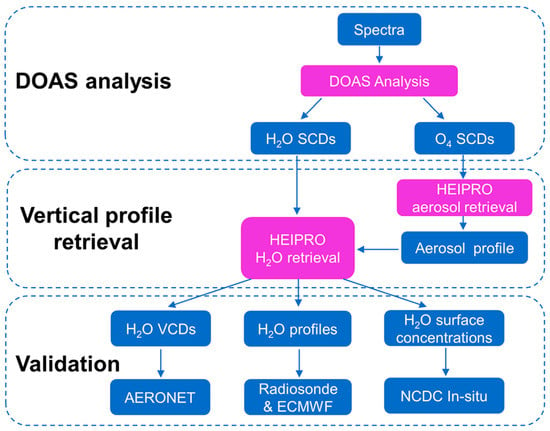Validation of Water Vapor Vertical Distributions Retrieved from MAX-DOAS over Beijing, China
Abstract
1. Introduction
2. Measurement and Methods
2.1. The MAX-DOAS Instrument
2.2. DOAS Spectral Analysis
2.3. HEIPRO Algorithm Description
3. Ancillary Data for Validation
- The MAX-DOAS water vapor VCDs were validated with AERONET Level 1.5 precipitable water data from the CAMS site, Beijing (39.933°N, 116.317°E; Elevation: 106.0 m).
- The MAX-DOAS water vapor surface concentrations were validated with NCDC surface meteorological data from the BCIA site (40.080°N, 116.585°E; Elevation: 35.4 m).
- The MAX-DOAS water vapor vertical profiles were validated with balloon-borne radiosonde data from the Nanjiao Observatory, Beijing (39.806°N, 116.470°E) and ECMWF ERA-interim reanalysis datasets.
3.1. AERONET Observation Data
3.2. NCDC Data
3.3. ECMWF ERA-Interim Reanalysis Data
3.4. Balloon-Borne Radiosonde Data
4. Results
4.1. Validation of VCDs Retrieved by MAX-DOAS
4.2. Validation of Surface Concentrations Retrieved by MAX-DOAS
4.3. Validations of Vertical Profiles Retrieved by MAX-DOAS
4.3.1. Validation with Balloon-Borne Radiosonde Measurements
4.3.2. Validation with ECMWF ERA-Interim Data
5. Discussion
5.1. Error Budget Analysis
5.2. Retrieval Performance under Different Aerosol Loads
6. Summary and Conclusions
Supplementary Materials
Author Contributions
Funding
Acknowledgments
Conflicts of Interest
References
- Moffett, K.B.; Wolf, A.; Berry, J.A.; Gorelick, S.M. Salt marsh–atmosphere exchange of energy, water vapor, and carbon dioxide: Effects of tidal flooding and biophysical controls. Water Resour. Res. 2010, 46, W10525. [Google Scholar] [CrossRef]
- Dai, A.; Wang, J.H.; Ware, R.H.; Van Hove, T. Diurnal variation in water vapor over North America and its implications for sampling errors in radiosonde humidity. J. Geophys. Res. Atmos. 2002, 107, ACL 11-1–ACL 11-14. [Google Scholar] [CrossRef]
- Chaboureau, J.P.; Chedin, A.; Scott, N.A. Remote Sens. of the vertical distribution of atmospheric water vapor from the TOVS observations: Method and validation. J. Geophys. Res. Atmos. 1998, 103, 8743–8752. [Google Scholar] [CrossRef]
- Guan, X.; Yang, L.; Zhang, Y.; Li, J. Spatial distribution, temporal variation, and transport characteristics of atmospheric water vapor over Central Asia and the arid region of China. Glob. Planet. Chang. 2019, 172, 159–178. [Google Scholar] [CrossRef]
- Noël, S.; Bramstedt, K.; Rozanov, A.; Bovensmann, H.; Burrows, J.P. Water vapour profiles from SCIAMACHY solar occultation measurements derived with an onion peeling approach. Atmos. Meas. Tech. 2010, 3, 523–535. [Google Scholar] [CrossRef]
- Gusakova, M.A.; Karlin, L.N. Assessment of contribution of greenhouse gases, water vapor, and cloudiness to the variations of global surface air temperature. Russ. Meteorol. Hydrol. 2014, 39, 146–151. [Google Scholar] [CrossRef]
- Li, L.; Tan, Q.; Zhang, Y.; Feng, M.; Qu, Y.; An, J.; Liu, X. Characteristics and source apportionment of PM2.5 during persistent extreme haze events in Chengdu, southwest China. Environ. Pollut. 2017, 230, 718–729. [Google Scholar] [CrossRef]
- Tie, X.; Huang, R.J.; Cao, J.; Zhang, Q.; Cheng, Y.; Su, H.; Chang, D.; Poschl, U.; Hoffmann, T.; Dusek, U.; et al. Severe Pollution in China Amplified by Atmospheric Moisture. Sci. Rep. 2017, 7, 15760. [Google Scholar] [CrossRef]
- Zhao, Y.; Yan, H.; Wu, P.; Zhou, D. Linear correction method for improved atmospheric vertical profile retrieval based on ground-based microwave radiometer. Atmos. Res. 2020, 232, 104678. [Google Scholar] [CrossRef]
- Wu, S.; Dai, G.; Song, X.; Liu, B.; Liu, L. Observations of water vapor mixing ratio profile and flux in the Tibetan Plateau based on the lidar technique. Atmos. Meas. Tech. 2016, 9, 1399–1413. [Google Scholar] [CrossRef]
- Seidel, D.J.; Sun, B.; Pettey, M.; Reale, A. Global radiosonde balloon drift statistics. J. Geophys. Res. 2011, 116, D07102. [Google Scholar] [CrossRef]
- Laroche, S.; Sarrazin, R. Impact of Radiosonde Balloon Drift on Numerical Weather Prediction and Verification. Weather Forecast. 2013, 28, 772–782. [Google Scholar] [CrossRef]
- Mace, G.G.; Starr, D.O.C.; Ackerman, T.P.; Minnis, P. Examination of Coupling between an Upper-Tropospheric Cloud System and Synoptic-Scale Dynamics Diagnosed from Wind Profiler and Radiosonde Data. J. Atmos. Sci. 1995, 52, 4094–4127. [Google Scholar] [CrossRef][Green Version]
- Kuwagata, T.; Numaguti, A.; Endo, N. Diurnal variation of water vapor over the central Tibetan Plateau during summer. J. Meteorol. Soc. Jpn. 2001, 79, 401–418. [Google Scholar] [CrossRef]
- Bianco, L.; Friedrich, K.; Wilczak, J.M.; Hazen, D.; Wolfe, D.; Delgado, R.; Oncley, S.P.; Lundquist, J.K. Assessing the accuracy of microwave radiometers and radio acoustic sounding systems for wind energy applications. Atmos. Meas. Tech. 2017, 10, 1707–1721. [Google Scholar] [CrossRef]
- Feltz, W.F.; Smith, W.L.; Knuteson, R.O.; Revercomb, H.E.; Woolf, H.M.; Howell, H.B. Meteorological Applications of Temperature and Water Vapor Retrievals from the Ground-Based Atmospheric Emitted Radiance Interferometer (AERI). J. Appl. Meteorol. 1998, 37, 857–875. [Google Scholar] [CrossRef]
- Löhnert, U.; Turner, D.D.; Crewell, S. Ground-Based Temperature and Humidity Profiling Using Spectral Infrared and Microwave Observations. Part I: Simulated Retrieval Performance in Clear-Sky Conditions. J. Appl. Meteorol. Climatol. 2009, 48, 1017–1032. [Google Scholar] [CrossRef]
- Roy, R.J.; Lebsock, M.; Millan, L.; Dengler, R.; Monje, R.R.; Siles, J.V.; Cooper, K.B. Boundary-layer water vapor profiling using differential absorption radar. Atmos. Meas. Tech. 2018, 11, 6511–6523. [Google Scholar] [CrossRef]
- Ehret, G.; Hoinka, K.P.; Stein, J.; Fix, A.; Kiemle, C.; Poberaj, G. Low stratospheric water vapor measured by an airborne DIAL. J. Geophys. Res. Atmos. 1999, 104, 31351–31359. [Google Scholar] [CrossRef]
- Browell, E.V.; Wilkerson, T.D.; McIlrath, T.J. Water vapor differential absorption lidar development and evaluation. Appl. Opt. 1979, 18, 3474–3483. [Google Scholar] [CrossRef]
- Whiteman, D.N.; Melfi, S.H.; Ferrare, R.A. Raman lidar system for the measurement of water vapor and aerosols in the Earth’s atmosphere. Appl. Opt. 1992, 31, 3068–3082. [Google Scholar] [CrossRef] [PubMed]
- Weber, K.J.; Weckwerth, T.M.; Turner, D.D.; Spuler, S.M. Validation of a Water Vapor Micropulse Differential Absorption Lidar (DIAL). J. Atmos. Ocean. Technol. 2016, 33, 2353–2372. [Google Scholar] [CrossRef]
- Honninger, G.; von Friedeburg, C.; Platt, U. Multi axis differential optical absorption spectroscopy (MAX-DOAS). Atmos. Chem. Phys. 2004, 4, 231–254. [Google Scholar] [CrossRef]
- Li, X.; Brauers, T.; Hofzumahaus, A.; Lu, K.; Li, Y.P.; Shao, M.; Wagner, T.; Wahner, A. MAX-DOAS measurements of NO2, HCHO and CHOCHO at a rural site in Southern China. Atmos. Chem. Phys. 2013, 13, 2133–2151. [Google Scholar] [CrossRef]
- Xing, C.Z.; Liu, C.; Wang, S.S.; Hu, Q.H.; Liu, H.R.; Tan, W.; Zhang, W.Q.; Li, B.; Liu, J.G. A new method to determine the aerosol optical properties from multiple-wavelength O4 absorptions by MAX-DOAS observation. Atmos. Meas. Tech. 2019, 12, 3289–3302. [Google Scholar] [CrossRef]
- Cheng, Y.; Wang, S.; Zhu, J.; Guo, Y.; Zhang, R.; Liu, Y.; Zhang, Y.; Yu, Q.; Ma, W.; Zhou, B. Surveillance of SO2 and NO2 from ship emissions by MAX-DOAS measurements and the implications regarding fuel sulfur content compliance. Atmos. Chem. Phys. 2019, 19, 13611–13626. [Google Scholar] [CrossRef]
- Suwen, L.; Fusheng, M.; Jing, L.; Wen, S.; Minhong, W.; Xude, W.; Lisha, H. Research of vertical profile of aerosol extinction based on measured the O4 of multi-elevation angles with MAX-DOAS. In Proceedings of the Optical Sensors and Sensing Congress (ES, FTS, HISE, Sensors), San Jose, CA, USA, 25–27 June 2019; p. JW3A-13. [Google Scholar]
- Javed, Z.; Liu, C.; Khokhar, M.F.; Tan, W.; Liu, H.R.; Xing, C.Z.; Ji, X.G.; Tanvir, A.; Hong, Q.Q.; Sandhu, O.; et al. Ground-Based MAX-DOAS Observations of CHOCHO and HCHO in Beijing and Baoding, China. Remote Sens. 2019, 11, 1524. [Google Scholar] [CrossRef]
- Zhang, J.; Wang, S.; Guo, Y.; Zhang, R.; Qin, X.; Huang, K.; Wang, D.; Fu, Q.; Wang, J.; Zhou, B. Aerosol vertical profile retrieved from ground-based MAX-DOAS observation and characteristic distribution during wintertime in Shanghai, China. Atmos. Environ. 2018, 192, 193–205. [Google Scholar] [CrossRef]
- Wagner, T.; Andreae, M.O.; Beirle, S.; Dörner, S.; Mies, K.; Shaiganfar, R. MAX-DOAS observations of the total atmospheric water vapour column and comparison with independent observations. Atmos. Meas. Tech. 2013, 6, 131–149. [Google Scholar] [CrossRef]
- Baidar, S.; Oetjen, H.; Coburn, S.; Dix, B.; Ortega, I.; Sinreich, R.; Volkamer, R. The CU Airborne MAX-DOAS instrument: Vertical profiling of aerosol extinction and trace gases. Atmos. Meas. Tech. 2013, 6, 719–739. [Google Scholar] [CrossRef]
- Irie, H.; Takashima, H.; Kanaya, Y.; Boersma, K.F.; Gast, L.; Wittrock, F.; Brunner, D.; Zhou, Y.; Van Roozendael, M. Eight-component retrievals from ground-based MAX-DOAS observations. Atmos. Meas. Tech. 2011, 4, 1027–1044. [Google Scholar] [CrossRef]
- Chance, K.; Kurucz, R.L. An improved high-resolution solar reference spectrum for earth’s atmosphere measurements in the ultraviolet, visible, and near infrared. J. Quant. Spectrosc. Radiat. Transf. 2010, 111, 1289–1295. [Google Scholar] [CrossRef]
- Vandaele, A.C.; Hermans, C.; Simon, P.C.; Carleer, M.; Colin, R.; Fally, S.; Merienne, M.F.; Jenouvrier, A.; Coquart, B. Measurements of the NO2 absorption cross-section from 42 000 cm−1 to 10 000 cm−1 (238–1000 nm) at 220 K and 294 K. J. Quant. Spectrosc. Radiat. Transf. 1998, 59, 171–184. [Google Scholar] [CrossRef]
- Thalman, R.; Volkamer, R. Temperature dependent absorption cross-sections of O2-O2 collision pairs between 340 and 630 nm and at atmospherically relevant pressure. Phys. Chem. Chem. Phys. 2013, 15, 15371–15381. [Google Scholar] [CrossRef]
- Serdyuchenko, A.; Gorshelev, V.; Weber, M.; Chehade, W.; Burrows, J.P. High spectral resolution ozone absorption cross-sections—Part 2: Temperature dependence. Atmos. Meas. Tech. 2014, 7, 625–636. [Google Scholar] [CrossRef]
- Volkamer, R.; Spietz, P.; Burrows, J.; Platt, U. High-resolution absorption cross-section of glyoxal in the UV-vis and IR spectral ranges. J. Photochem. Photobiol. A Chem. 2005, 172, 35–46. [Google Scholar] [CrossRef]
- Rothman, L.S.; Gordon, I.E.; Barbe, A.; Benner, D.C.; Bernath, P.E.; Birk, M.; Boudon, V.; Brown, L.R.; Campargue, A.; Champion, J.P.; et al. The HITRAN 2008 molecular spectroscopic database. J. Quant. Spectrosc. Radiat. Transf. 2009, 110, 533–572. [Google Scholar] [CrossRef]
- Chance, K.V.; Spurr, R.J.D. Ring effect studies: Rayleigh scattering, including molecular parameters for rotational Raman scattering, and the Fraunhofer spectrum. Appl. Opt. 1997, 36, 5224–5230. [Google Scholar] [CrossRef]
- Frieß, U.; Monks, P.S.; Remedios, J.J.; Rozanov, A.; Sinreich, R.; Wagner, T.; Platt, U. MAX-DOAS O4 measurements: A new technique to derive information on atmospheric aerosols: 2. Modeling studies. J. Geophys. Res. 2006, 111, D14203. [Google Scholar] [CrossRef]
- Wagner, T.; Dix, B.; Friedeburg, C.v.; Frieß, U.; Sanghavi, S.; Sinreich, R.; Platt, U. MAX-DOAS O4 measurements: A new technique to derive information on atmospheric aerosols—Principles and information content. J. Geophys. Res. Atmos. 2004, 109, D22205. [Google Scholar] [CrossRef]
- Frieß, U.; Klein Baltink, H.; Beirle, S.; Clémer, K.; Hendrick, F.; Henzing, B.; Irie, H.; de Leeuw, G.; Li, A.; Moerman, M.M.; et al. Intercomparison of aerosol extinction profiles retrieved from MAX-DOAS measurements. Atmos. Meas. Tech. 2016, 9, 3205–3222. [Google Scholar] [CrossRef]
- Ryan, R.G.; Rhodes, S.; Tully, M.; Wilson, S.; Jones, N.; Friess, U.; Schofield, R. Daytime HONO, NO2 and aerosol distributions from MAX-DOAS observations in Melbourne. Atmos. Chem. Phys. 2018, 18, 13969–13985. [Google Scholar] [CrossRef]
- Wang, S.; Cuevas, C.A.; Frieß, U.; Saiz-Lopez, A. MAX-DOAS retrieval of aerosol extinction properties in Madrid, Spain. Atmos. Meas. Tech. 2016, 9, 5089–5101. [Google Scholar] [CrossRef]
- Xing, C.; Liu, C.; Wang, S.; Chan, K.L.; Gao, Y.; Huang, X.; Su, W.; Zhang, C.; Dong, Y.; Fan, G.; et al. Observations of the vertical distributions of summertime atmospheric pollutants and the corresponding ozone production in Shanghai, China. Atmos. Chem. Phys. 2017, 17, 14275–14289. [Google Scholar] [CrossRef]
- Xing, C.Z.; Liu, C.; Hu, Q.H.; Fu, Q.Y.; Lin, H.; Wang, S.T.; Su, W.J.; Wang, W.W.; Javed, Z.; Liu, J.G. Identifying the wintertime sources of volatile organic compounds (VOCs) from MAX-DOAS measured formaldehyde and glyoxal in Chongqing, southwest China. Sci. Total Environ. 2020, 715, 136258. [Google Scholar] [CrossRef]
- Frieß, U.; Beirle, S.; Alvarado Bonilla, L.; Bösch, T.; Friedrich, M.M.; Hendrick, F.; Piters, A.; Richter, A.; van Roozendael, M.; Rozanov, V.V.; et al. Intercomparison of MAX-DOAS Vertical Profile Retrieval Algorithms: Studies using Synthetic Data. Atmos. Meas. Tech. Discuss. 2018. [Google Scholar] [CrossRef]
- Rozanov, V.V.; Rozanov, A.V.; Kokhanovsky, A.A.; Burrows, J.P. Radiative transfer through terrestrial atmosphere and ocean: Software package SCIATRAN. J. Quant. Spectrosc. Radiat. Transf. 2014, 133, 13–71. [Google Scholar] [CrossRef]
- Ma, J.Z.; Beirle, S.; Jin, J.L.; Shaiganfar, R.; Yan, P.; Wagner, T. Tropospheric NO2 vertical column densities over Beijing: Results of the first three years of ground-based MAX-DOAS measurements (2008–2011) and satellite validation. Atmos. Chem. Phys. 2013, 13, 1547–1567. [Google Scholar] [CrossRef]
- Schofield, R.; Connor, B.; Kreher, K.; Johnston, P.; Rodgers, C. The retrieval of profile and chemical information from ground-based UV-visible spectroscopic measurements. J. Quant. Spectrosc. Radiat. Transf. 2004, 86, 115–131. [Google Scholar] [CrossRef]
- Vlemmix, T.; Hendrick, F.; Pinardi, G.; De Smedt, I.; Fayt, C.; Hermans, C.; Piters, A.; Wang, P.; Levelt, P.; Van Roozendael, M. MAX-DOAS observations of aerosols, formaldehyde and nitrogen dioxide in the Beijing area: Comparison of two profile retrieval approaches. Atmos. Meas. Tech. 2015, 8, 941–963. [Google Scholar] [CrossRef]
- Chan, K.L.; Wang, Z.; Ding, A.; Heue, K.-P.; Shen, Y.; Wang, J.; Zhang, F.; Shi, Y.; Hao, N.; Wenig, M. MAX-DOAS measurements of tropospheric NO2 and HCHO in Nanjing and a comparison to ozone monitoring instrument observations. Atmos. Chem. Phys. 2019, 19, 10051–10071. [Google Scholar] [CrossRef]
- Holben, B.N.; Eck, T.F.; Slutsker, I.; Tanre, D.; Buis, J.P.; Setzer, A.; Vermote, E.; Reagan, J.A.; Kaufman, Y.J.; Nakajima, T.; et al. AERONET—A federated instrument network and data archive for aerosol characterization. Remote Sens. Environ. 1998, 66, 1–16. [Google Scholar] [CrossRef]
- Smirnov, A.; Holben, B.N.; Eck, T.F.; Dubovik, O.; Slutsker, I. Cloud-Screening and Quality Control Algorithms for the AERONET Database. Remote Sens. Environ. 2000, 73, 337–349. [Google Scholar] [CrossRef]
- Hoque, H.M.S.; Irie, H.; Damiani, A.; Momoi, M. Primary Evaluation of the GCOM-C Aerosol Products at 380 nm Using Ground-Based Sky Radiometer Observations. Remote Sens. 2020, 12, 2661. [Google Scholar] [CrossRef]
- Dee, D.P.; Uppala, S.M.; Simmons, A.J.; Berrisford, P.; Poli, P.; Kobayashi, S.; Andrae, U.; Balmaseda, M.A.; Balsamo, G.; Bauer, P.; et al. The ERA-Interim reanalysis: Configuration and performance of the data assimilation system. Q. J. R. Meteorol. Soc. 2011, 137, 553–597. [Google Scholar] [CrossRef]
- Yao, Y.; Xin, L.; Zhao, Q. An improved pixel-based water vapor tomography model. Ann. Geophys. 2019, 37, 89–100. [Google Scholar] [CrossRef]
- Tan, W.; Liu, C.; Wang, S.; Xing, C.; Su, W.; Zhang, C.; Xia, C.; Liu, H.; Cai, Z.; Liu, J. Tropospheric NO2, SO2, and HCHO over the East China Sea, using ship-based MAX-DOAS observations and comparison with OMI and OMPS satellite data. Atmos. Chem. Phys. 2018, 18, 15387–15402. [Google Scholar] [CrossRef]
- Wang, X.; Gong, Y. The impact of an urban dry island on the summer heat wave and sultry weather in Beijing City. Chin.Sci. Bull. 2010, 55, 1657–1661. [Google Scholar] [CrossRef]
- Yang, P.; Ren, G.; Hou, W. Temporal–Spatial Patterns of Relative Humidity and the Urban Dryness Island Effect in Beijing City. J. Appl. Meteorol. Climatol. 2017, 56, 2221–2237. [Google Scholar] [CrossRef]
- Rodgers, C. Inverse Methods for Atmospheric Sounding: Theory and Practice, Series on Atmospheric, Oceanic and Planetary Physics; World Scientific Publishing Co.: Singapore, 2000. [Google Scholar] [CrossRef]
- Hong, Q.Q.; Liu, C.; Hu, Q.H.; Xing, C.Z.; Tan, W.; Liu, H.R.; Huang, Y.; Zhu, Y.; Zhang, J.S.; Geng, T.Z.; et al. Evolution of the vertical structure of air pollutants during winter heavy pollution episodes: The role of regional transport and potential sources. Atmos. Res. 2019, 228, 206–222. [Google Scholar] [CrossRef]
- Friedrich, M.M.; Rivera, C.; Stremme, W.; Ojeda, Z.; Arellano, J.; Bezanilla, A.; García-Reynoso, J.A.; Grutter, M. NO2 vertical profiles and column densities from MAX-DOAS measurements in Mexico City. Atmos. Meas. Tech. 2019, 12, 2545–2565. [Google Scholar] [CrossRef]
- Wang, Y.; Lampel, J.; Xie, P.; Beirle, S.; Li, A.; Wu, D.; Wagner, T. Ground-based MAX-DOAS observations of tropospheric aerosols, NO2, SO2 and HCHO in Wuxi, China, from 2011 to 2014. Atmos. Chem. Phys. 2017, 17, 2189–2215. [Google Scholar] [CrossRef]
- Wang, T.; Hendrick, F.; Wang, P.; Tang, G.; Clemer, K.; Yu, H.; Fayt, C.; Hermans, C.; Gielen, C.; Muller, J.F.; et al. Evaluation of tropospheric SO2 retrieved from MAX-DOAS measurements in Xianghe, China. Atmos. Chem. Phys. 2014, 14, 11149–11164. [Google Scholar] [CrossRef]
- Wagner, T.; Heland, J.; Zoger, M.; Platt, U. A fast H2O total column density product from GOME—Validation with in-situ aircraft measurements. Atmos. Chem. Phys. 2003, 3, 651–663. [Google Scholar] [CrossRef]
- Chan, K.L.; Hartl, A.; Lam, Y.F.; Xie, P.H.; Liu, W.Q.; Cheung, H.M.; Lampel, J.; Poehler, D.; Li, A.; Xu, J.; et al. Observations of tropospheric NO2 using ground based MAX-DOAS and OMI measurements during the Shanghai World Expo 2010. Atmos. Environ. 2015, 119, 45–58. [Google Scholar] [CrossRef]
- Garcia-Nieto, D.; Benavent, N.; Saiz-Lopez, A. Measurements of atmospheric HONO vertical distribution and temporal evolution in Madrid (Spain) using the MAX-DOAS technique. Sci. Total Environ. 2018, 643, 957–966. [Google Scholar] [CrossRef]
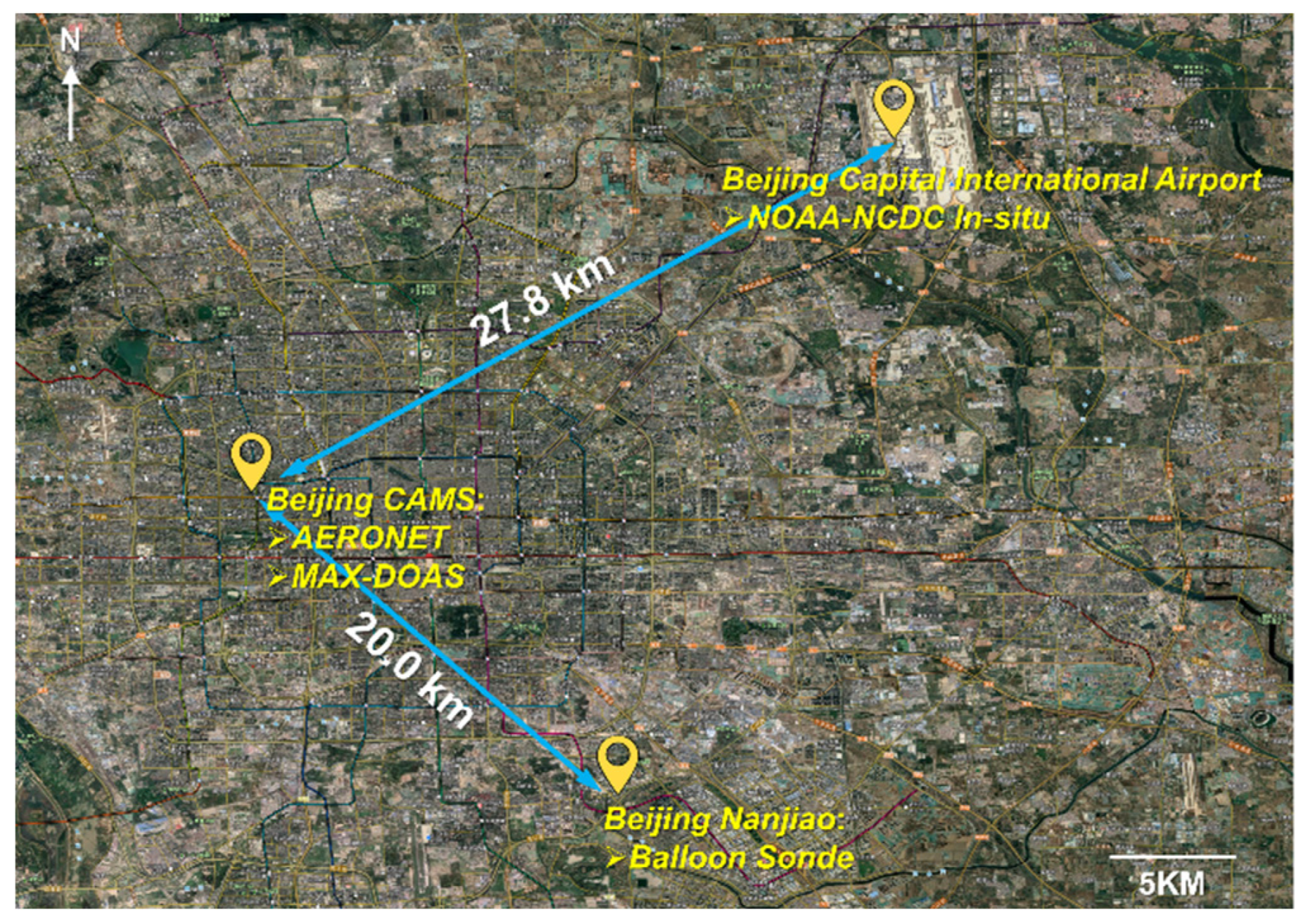
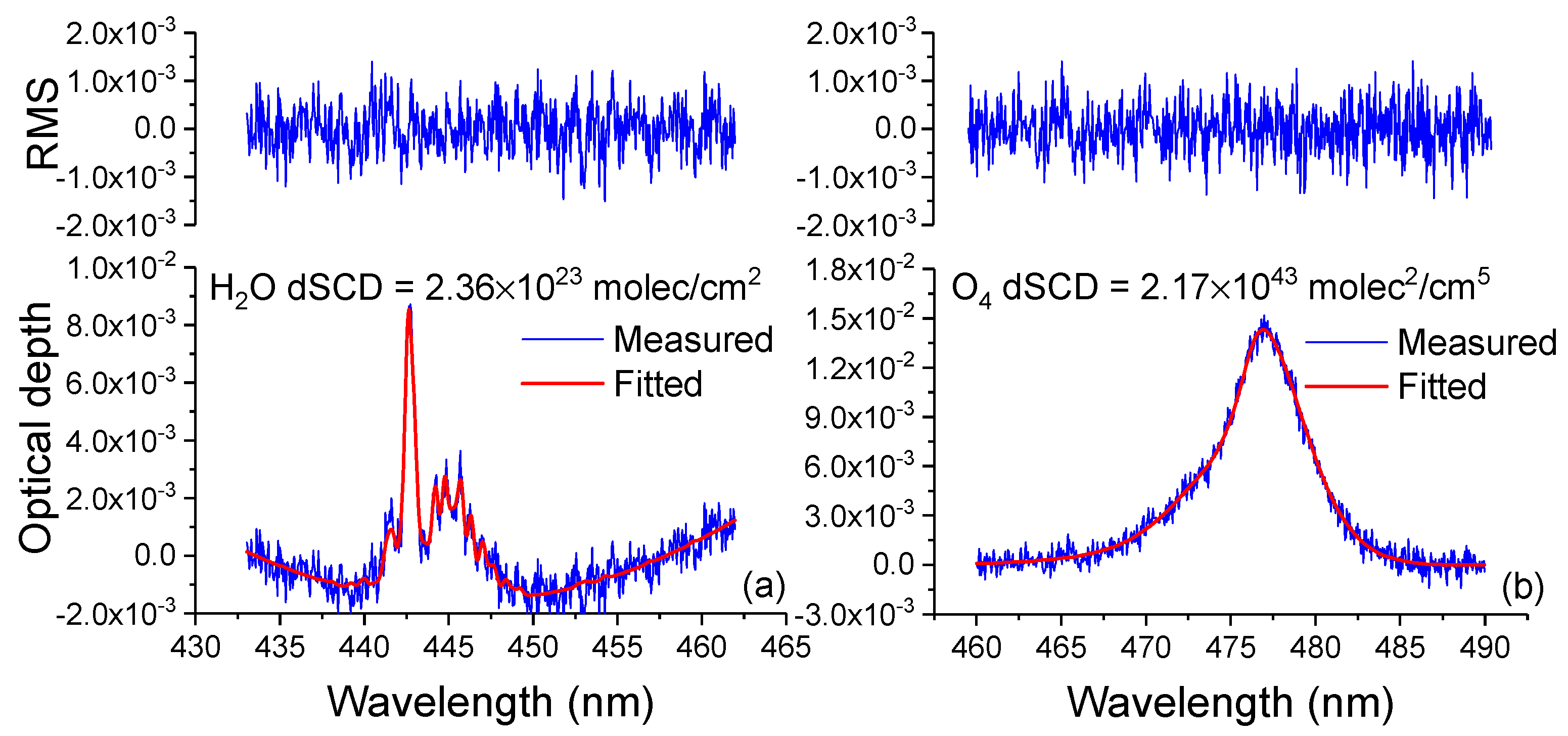
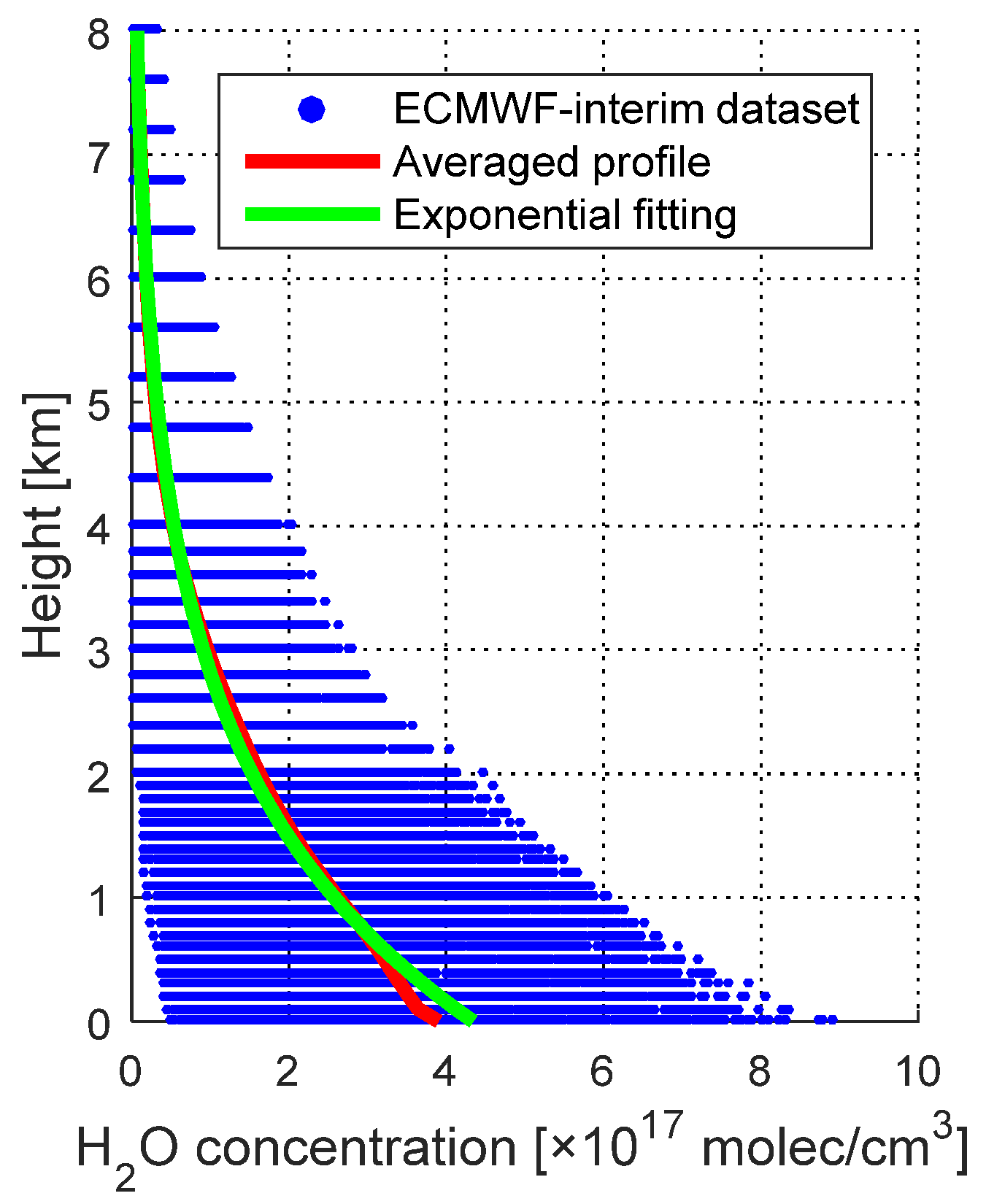
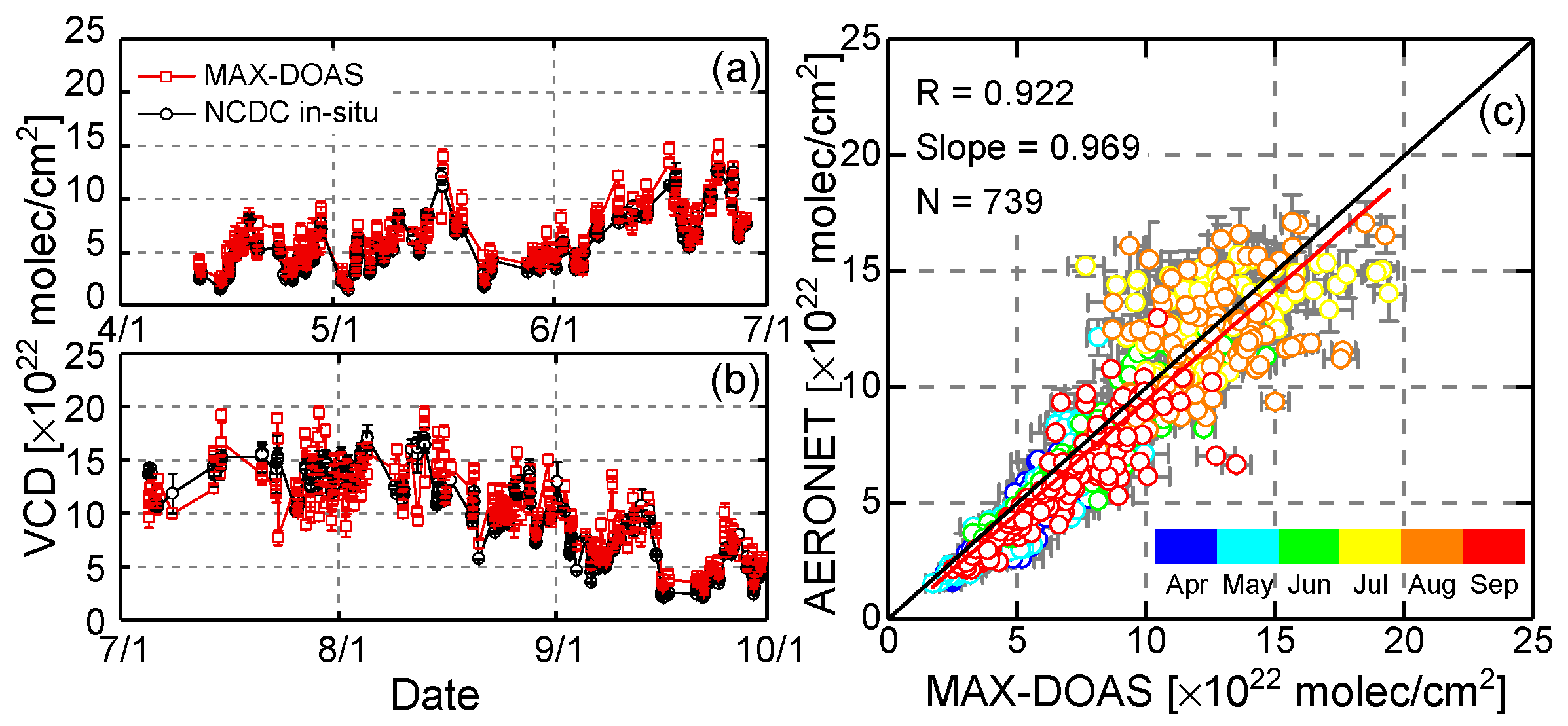
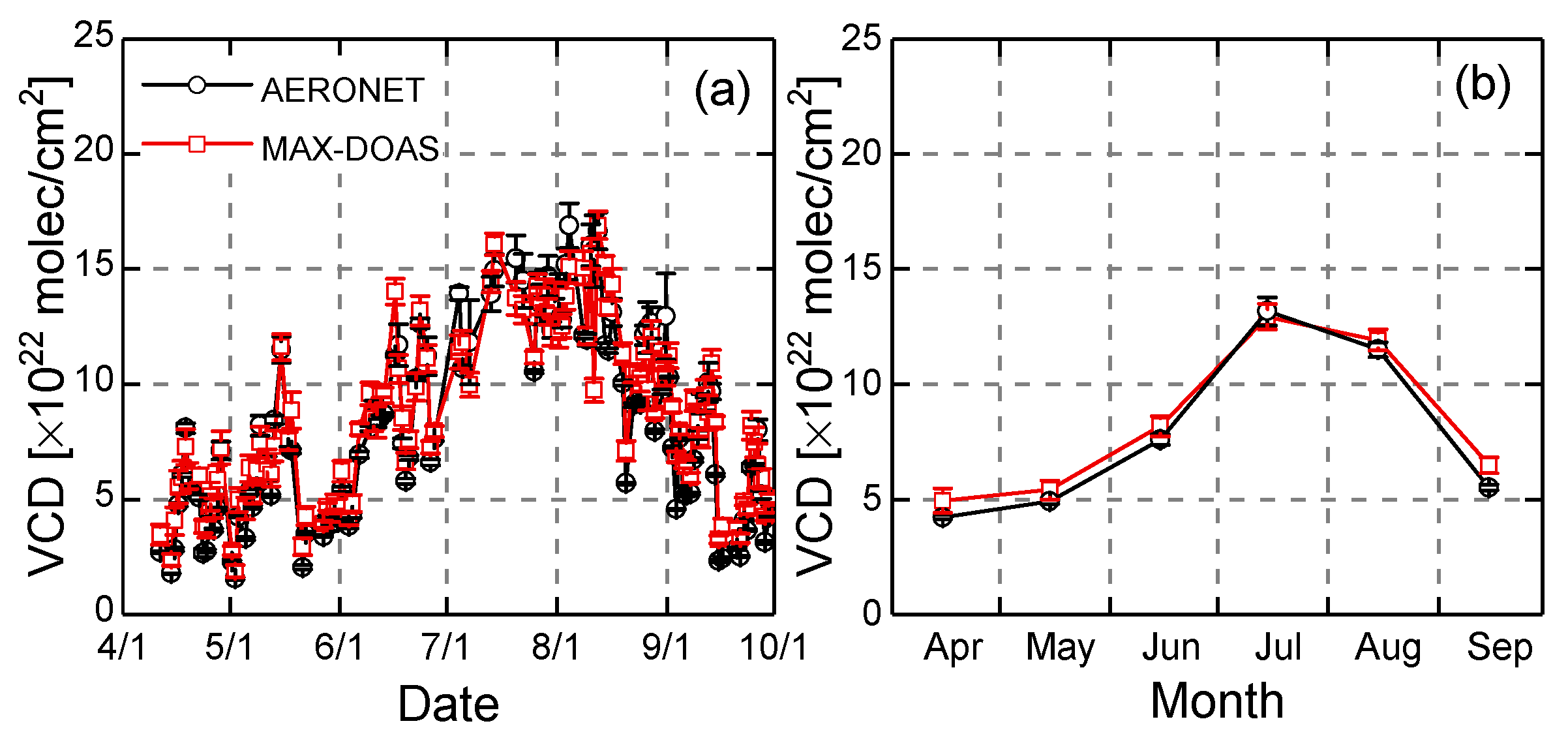
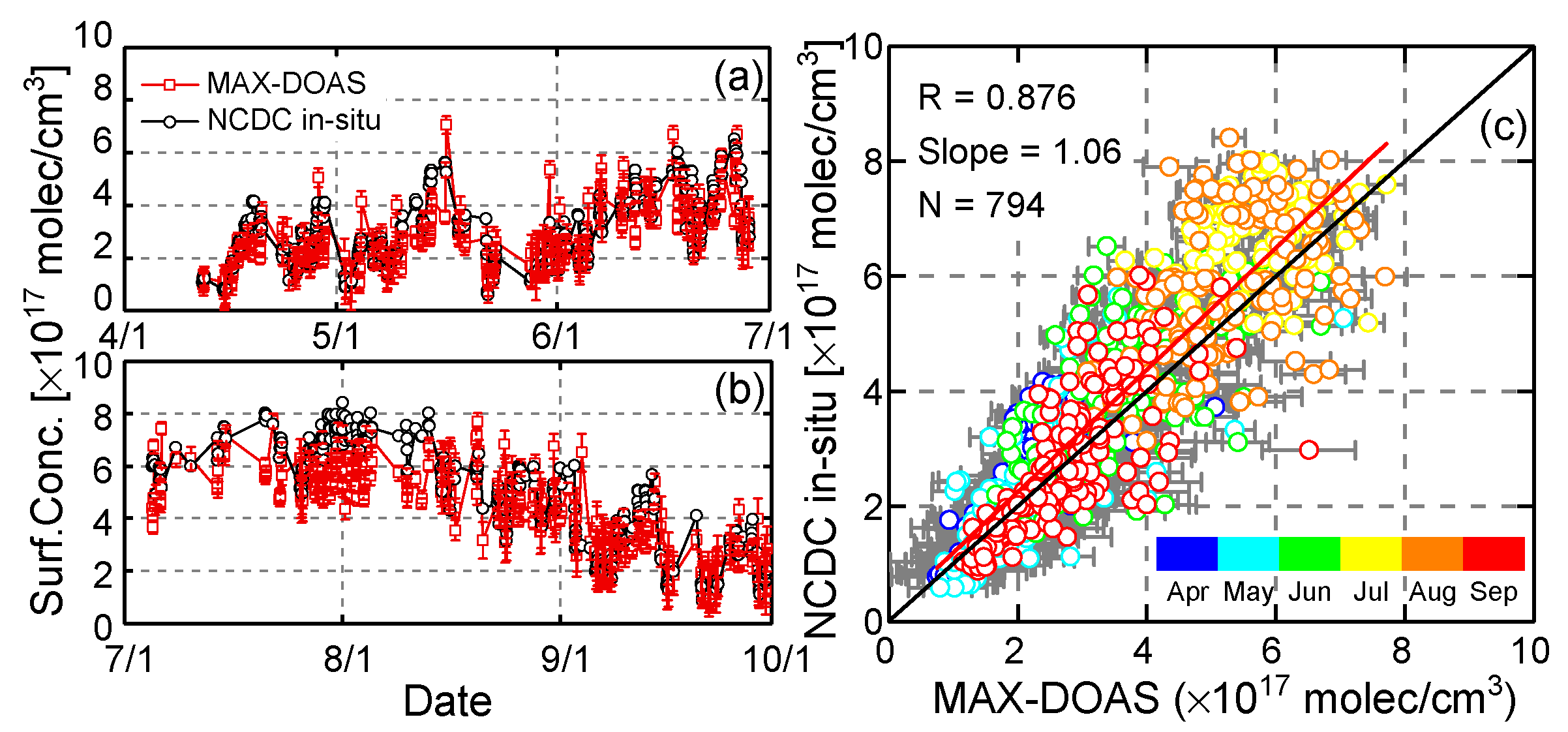
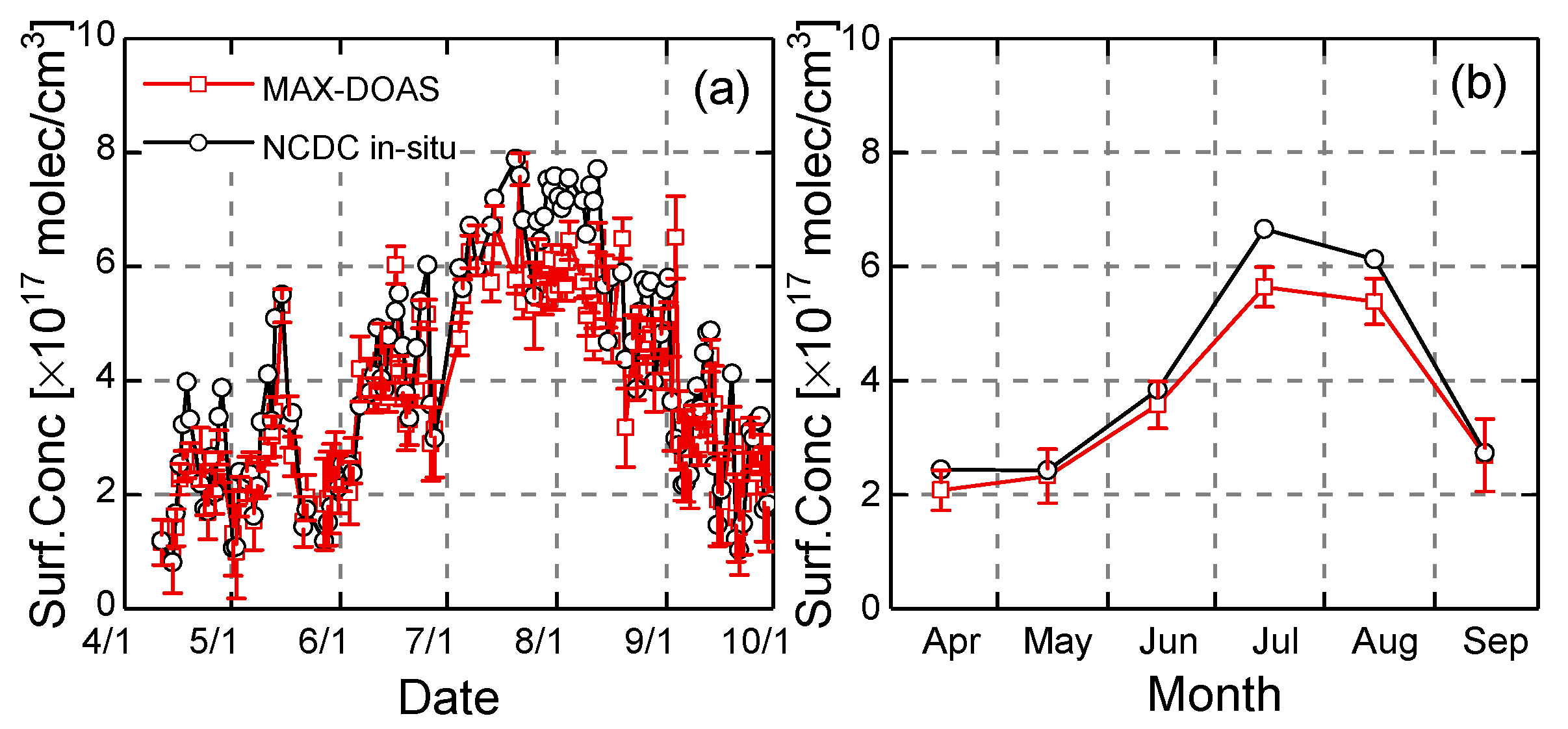

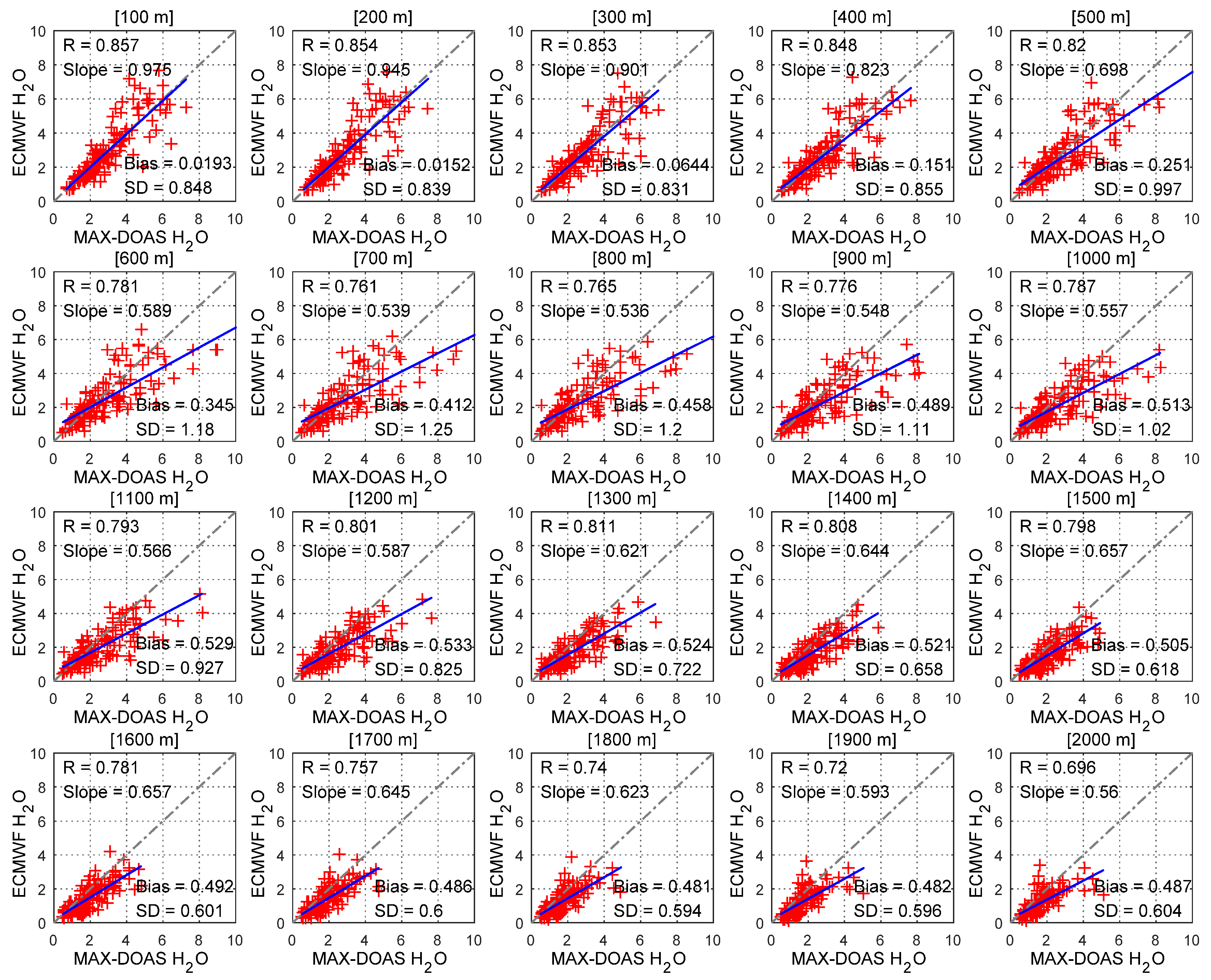


| Parameters | Data Source | Target Component | |
|---|---|---|---|
| H2O | O4 | ||
| Fitting window | 433–462 nm | 460–490 nm | |
| NO2 | 298 K [34] | √ | √ |
| NO2 | 220 K [34] | √ | √ |
| O4 | 293 K [35] | √ | √ |
| O3 | 223 K [36] | √ | √ |
| Glyoxal | 298 K [37] | √ | |
| H2O | 293 K, 1021 hPa [38] | √ | √ |
| Ring | Calculated with QDOAS [39] | √ | √ |
| Polynomial degree | 3rd order | 5th order | |
| Intensity offset | Constant | Constant | |
| Uncertainty | Surf. Concentration (0–100 m) | VCD |
|---|---|---|
| Smoothing and noise error | 13% | 36% |
| Uncertainty related to aerosols | 28% | 5% |
| Uncertainty related to a priori profile | 2% | 7% |
| Uncertainty in H2O cross section | 3% | 3% |
| Algorithm error | 1% | 8% |
| Total error | 31% | 38% |
© 2020 by the authors. Licensee MDPI, Basel, Switzerland. This article is an open access article distributed under the terms and conditions of the Creative Commons Attribution (CC BY) license (http://creativecommons.org/licenses/by/4.0/).
Share and Cite
Lin, H.; Liu, C.; Xing, C.; Hu, Q.; Hong, Q.; Liu, H.; Li, Q.; Tan, W.; Ji, X.; Wang, Z.; et al. Validation of Water Vapor Vertical Distributions Retrieved from MAX-DOAS over Beijing, China. Remote Sens. 2020, 12, 3193. https://doi.org/10.3390/rs12193193
Lin H, Liu C, Xing C, Hu Q, Hong Q, Liu H, Li Q, Tan W, Ji X, Wang Z, et al. Validation of Water Vapor Vertical Distributions Retrieved from MAX-DOAS over Beijing, China. Remote Sensing. 2020; 12(19):3193. https://doi.org/10.3390/rs12193193
Chicago/Turabian StyleLin, Hua, Cheng Liu, Chengzhi Xing, Qihou Hu, Qianqian Hong, Haoran Liu, Qihua Li, Wei Tan, Xiangguang Ji, Zhuang Wang, and et al. 2020. "Validation of Water Vapor Vertical Distributions Retrieved from MAX-DOAS over Beijing, China" Remote Sensing 12, no. 19: 3193. https://doi.org/10.3390/rs12193193
APA StyleLin, H., Liu, C., Xing, C., Hu, Q., Hong, Q., Liu, H., Li, Q., Tan, W., Ji, X., Wang, Z., & Liu, J. (2020). Validation of Water Vapor Vertical Distributions Retrieved from MAX-DOAS over Beijing, China. Remote Sensing, 12(19), 3193. https://doi.org/10.3390/rs12193193








